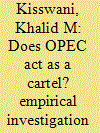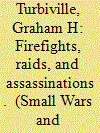|
|
|
Sort Order |
|
|
|
Items / Page
|
|
|
|
|
|
|
| Srl | Item |
| 1 |
ID:
150028


|
|
|
|
|
| Summary/Abstract |
In this paper I use quarterly and monthly data from 1994 to 2014 to test if OPEC acts as a cartel, and therefore, it affects oil prices through members' coordination. I use Engle and Granger two-step approach, Johansen cointegration test and Autoregressive Distributed Lag (ARDL) bounds testing approach of cointegration to examine the long-run relation between OPEC production and each member's production as an evidence of coordination. Besides, I apply Granger causality and Toda and Yamamoto tests to check the direction of causality between the OPEC production and oil prices (U.K. Brent and Dubai Fateh). The findings show no evidence of cointegration between the production of the members and that of OPEC, indicating no cartel behavior exists. Moreover, the results show that OPEC production does not cause oil prices; rather it is the other way around.
|
|
|
|
|
|
|
|
|
|
|
|
|
|
|
|
| 2 |
ID:
093828


|
|
|
|
|
| Publication |
2010.
|
| Summary/Abstract |
This article examines some specific types of narco-generated combat, assault, and brutality that over the last decade have acquired an increasingly organized and paramilitary character. The planning; training; intelligence and counterintelligence preparation; mobility; communications; type of weaponry; levels of intensity; and sheer audacity substantially exceed the threats with which traditional law enforcement had been trained and equipped to deal. It matches the apt Drug Enforcement Administration description of a 'transition from the gangsterism of traditional narco hit men to paramilitary terrorism with guerrilla tactics'. These methods have become a mainstay in the struggle of narco-traffickers against law enforcement, the military, and to a major degree among the competing drug-trafficking organizations themselves. While the infrastructure and practice of paramilitary violence is established in Mexico in seemingly unprecedented ways, the concern north of the border is its potential transportability. Many law enforcement personnel have compared 1980s Miami - with its running drug firefights, revenge raids, and bloody assassinations by Colombian cocaine traffickers - to Mexican drug violence. There are enough precursors north of the Rio Grande now to make the potential for something analogous more than empty speculation.
|
|
|
|
|
|
|
|
|
|
|
|
|
|
|
|
| 3 |
ID:
093825


|
|
|
|
|
| Publication |
2010.
|
| Summary/Abstract |
Today, analysts of the postmodern era recognize that worldwide conflicts are increasingly influenced by the interaction between terrorists, criminals, gangs, and private armies and that this interaction is a threat to the nation state. Now, a related threat is coming into play - one that involves all of these types of groups being represented at once in a single adversary. One such multifaceted group that is in the forefront is Los Zetas, a band of Mexican cartel enforcers that cannot be easily categorized, assessed, or targeted. Within broad categories of a multitude of irregular groups, Los Zetas embodies such capabilities as extensive compartmentalized networking, pervasive intelligence and counterintelligence capabilities, amassing of advanced weaponry, brutal tactics, top level military and police training, and the ability to undermine state governments and control large swaths of territory. Los Zetas, if left unchecked and unexamined, could potentially become a great security problem for Mexico, the US, and Central America. This essay provides an operational assessment that explores Los Zetas using various criteria traditionally used by nation state militaries, and more recently by Terrorism Early Warning Groups, to assess opposing forces (OPFOR). The purpose of this operational assessment is to provide a baseline understanding of Los Zetas that would make them less imposing and more targetable.
|
|
|
|
|
|
|
|
|
|
|
|
|
|
|
|
|
|
|
|
|